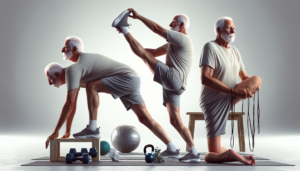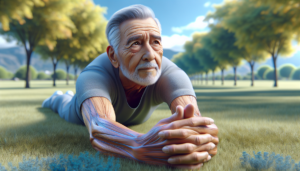Importance of Flexibility in Aging
As I move through the stages of aging, I recognize the crucial role that flexibility plays in maintaining my overall health and mobility. Understanding the impact of aging on flexibility and the multitude of benefits that flexibility exercises can bring is essential to my well-being as an older man.
Impact of Aging on Flexibility
With each passing year, I notice subtle changes in my body’s flexibility. The natural aging process can lead to a decrease in flexibility as muscles, joints, and tendons undergo various changes, affecting mobility and strength (One Medical). Ligaments become less elastic, reducing my mobility, while changes in tendons restrict joint mobility. These changes can contribute to postural imbalances, movement limitations, and an increased risk of falling (NCBI).
Moreover, the decrease in flexibility due to aging impacts not only my physical health but also my mental well-being. Regular stretching can help decrease tension and stress, improve posture and balance, and reduce the risk of future injuries. Embracing flexibility exercises can lead to positive mental well-being and relaxation, essential elements for a fulfilling life.
Benefits of Flexibility for Older Adults
Despite the inevitable changes that come with aging, it’s comforting to know that age-related loss of flexibility is reversible with the right exercises and activities. Flexibility tends to decrease with age due to decreased use, sedentary lifestyles, and lack of movement, but it doesn’t have to be a permanent state (MoreLifeHealth). Strengthening flexibility through activities such as yoga, pilates, swimming, Tai Chi, dancing, massage, foam rolling, and various stretching exercises can significantly improve overall flexibility, strength, coordination, and even reduce pain.
Understanding the impact of aging on flexibility and embracing the benefits that flexibility exercises can bring is empowering. It allows me to take charge of my health, improve joint health, reduce stiffness, and increase my overall mobility. By incorporating effective flexibility routines tailored to my needs and lifestyle, I can enhance the quality of my life as I gracefully navigate the journey of aging.
Types of Flexibility Exercises
When it comes to enhancing flexibility through fitness, there are various types of flexibility exercises that can benefit older men looking to improve joint health and increase overall mobility. These exercises are essential for reducing stiffness and enhancing range of motion, contributing to a better quality of life. Let’s explore three key types of flexibility exercises: static stretching, dynamic stretching, and PNF stretching.
Static Stretching
Static stretching is a foundational form of stretching commonly used by athletes, older adults, and rehabilitation patients. In this type of stretch, a specific position is held with the muscle under tension. According to NCBI, regular static stretching, performed at least two to three times a week for 5 to 10 minutes each session, can significantly improve flexibility and range of motion in joints. This type of stretching focuses on elongating the muscle to improve its flexibility and pliability.
| Benefits of Static Stretching |
|---|
| Improves flexibility |
| Increases range of motion |
| Reduces muscle tension |
For detailed stretching routines tailored for seniors, check out our article on stretching routines for seniors.
Dynamic Stretching
Dynamic stretching involves active stretches performed in a controlled manner and repeated in a short time frame to warm up the muscles. This type of stretching has been shown to enhance power and performance in activities such as jumping and running, making it particularly beneficial for athletes like basketball players or sprinters (NCBI).
Additionally, incorporating gentle movements from exercises like tai chi, Pilates, or yoga can further enhance flexibility in specific movements, which is especially beneficial for older adults. These dynamic movements not only improve flexibility but also help reduce the risk of falls and enhance balance, crucial considerations for older individuals.
| Benefits of Dynamic Stretching |
|---|
| Improves power and performance |
| Enhances flexibility in specific movements |
| Aids in warm-up and preparation for physical activities |
To discover personalized flexibility exercises for older men, explore our article on flexibility exercises for older men.
PNF Stretching
Proprioceptive Neuromuscular Facilitation (PNF) stretching is an advanced form of flexibility exercise that combines stretching with muscle contraction. This method has been proven effective for improving flexibility in older adults, as it targets both the muscles and the nervous system. PNF stretching can help increase the range of motion in joints and enhance muscular strength (MoreLifeHealth).
For a holistic approach to mobility and flexibility, incorporating a combination of static, dynamic, and PNF stretching exercises into your routine can help you achieve greater joint health, reduce stiffness, and increase overall mobility. By customizing your flexibility routine and including exercises that cater to your individual needs, you can work towards a more flexible and mobile lifestyle.
Effective Flexibility Routines
When it comes to enhancing flexibility as I advance in age, customizing my flexibility routine is key to nurturing my joint health and overall mobility. By tailoring my stretching regimen to my individual needs and goals, I can optimize the benefits gained from my senior fitness journey.
Customizing Your Flexibility Routine
Personalizing my flexibility routine involves understanding my body’s unique requirements and limitations. By focusing on areas that tend to be tighter or less mobile, I can address specific issues such as stiffness or reduced range of motion. Incorporating a variety of stretching techniques, including static stretching, dynamic stretching, and PNF stretching, allows me to target different muscle groups and improve overall flexibility.
To make my flexibility routine more effective, I can consider increasing the duration of each stretch beyond the typical 15 to 30 seconds. Research suggests that longer hold times, such as 60-second stretches, can lead to greater improvements in flexibility, especially for areas like the hamstrings. By incorporating these longer hold times into my routine, I can maximize the benefits of my stretching exercises.
Incorporating Balance and Strength Exercises
In addition to flexibility training, incorporating balance and strength exercises into my routine can further enhance my overall physical well-being and reduce the risk of falls. Strengthening exercises help build muscle mass and improve joint stability, while balance exercises focus on enhancing coordination and proprioception.
By combining flexibility, strength, and balance exercises, I can create a comprehensive fitness program that promotes functional independence and a higher quality of life. Activities like yoga, pilates, swimming, Tai Chi, and dancing not only support flexibility but also improve strength, coordination, and mental well-being. These holistic approaches to fitness cater to the unique needs of older adults like myself, helping me stay active, confident, and resilient as I age gracefully.
To further enhance my fitness routine, I can explore a variety of activities, including massage, foam rolling, and targeted stretching exercises. These practices not only promote flexibility but also aid in reducing pain and enhancing overall mobility (One Medical). By embracing a multifaceted approach to senior fitness, I can cultivate a strong, flexible, and resilient body that supports me in all aspects of my daily life.
Flexibility Exercises for Seniors
As I embark on the journey to enhance my flexibility and mobility, incorporating targeted stretching exercises is vital for maintaining joint health, reducing stiffness, and improving overall mobility. Let’s explore specific stretching routines tailored to address the needs of older men like me.
Stretching for Lower Body
Starting with the lower body, stretching exercises play a crucial role in improving flexibility and mobility in areas such as the hips, thighs, and calves. These stretches not only help to increase range of motion but also aid in preventing falls by enhancing balance and strength.
One effective lower body stretch is the seated hamstring stretch. This stretch targets the back of the thighs and can be performed while seated on a chair or the edge of a bed. By gently leaning forward and reaching towards the toes, the hamstrings are lengthened, promoting flexibility in the lower body.
Stretching for Upper Body
Moving on to the upper body, focusing on stretches for the shoulders, chest, and back is essential for maintaining flexibility in this region. These stretches help in relieving tension, improving posture, and enhancing overall mobility in daily activities.
A simple yet effective upper body stretch is the shoulder stretch. This stretch involves gently bringing one arm across the body and using the opposite hand to press the arm towards the chest. By holding this stretch for a few seconds on each side, the shoulder muscles are stretched, promoting flexibility in the upper body.
Comprehensive Flexibility Routine
For a comprehensive flexibility routine that targets both the lower and upper body, incorporating a variety of stretching exercises is key. Customizing a routine that includes a mix of static, dynamic, and PNF stretching can help in addressing different muscle groups and promoting overall flexibility and strength.
By incorporating balance and strength exercises alongside flexibility routines, older men can not only improve their range of motion but also enhance stability and coordination. These exercises are crucial in maintaining independence and reducing the risk of injury as I continue to prioritize my health and well-being in my senior years.
As I progress on my fitness journey, regularly performing these flexibility exercises tailored for seniors will not only help me stay active but also improve my quality of life by enhancing my mobility, reducing stiffness, and promoting overall well-being. For more resources on flexibility exercises for older men, visit our article on flexibility exercises for older men and mobility workout for older men.
Improving Flexibility and Mobility
As we age, maintaining flexibility and mobility becomes increasingly important for our overall well-being. To enhance your joint health, reduce stiffness, and increase mobility, it’s essential to focus on improving flexibility. Two key aspects of this journey are conducting flexibility tests to assess your current range of motion and engaging in activities designed to enhance flexibility.
Flexibility Tests for Seniors
Seniors can gauge their flexibility levels through simple at-home tests like the Sit & Reach Test, Tying Shoelaces Test, and Scratch Your Back/Brush Your Hair Test. These tests target areas vital for everyday tasks such as walking, balance, reaching, grooming, and dressing. By regularly performing these assessments, you can track your progress and tailor your stretching routine for seniors to address areas that need improvement (MoreLifeHealth).
| Flexibility Test | Purpose |
|---|---|
| Sit & Reach Test | Measure flexibility of lower back and hamstrings |
| Tying Shoelaces Test | Assess flexibility and reach of the lower body |
| Scratch Your Back/Brush Your Hair Test | Test upper body flexibility and reach |
By incorporating these tests into your fitness routine, you can set specific goals for improving your flexibility and mobility, ultimately enhancing your quality of life.
Activities to Enhance Flexibility
Engaging in activities specifically designed to enhance flexibility is crucial for seniors looking to maintain and improve their range of motion. Stretching exercises not only aid in preventing falls by promoting balance and overall strength but also contribute to regulating blood glucose levels and enhancing mental well-being.
Simple static stretches are versatile, gentle, and can be performed daily to relieve joint stiffness and muscle tension. These stretches target key muscle groups, including the lower back, hamstrings, and hip flexors, which are common areas of tightness for seniors.
Incorporating a variety of stretches, such as static stretching, dynamic stretching, and PNF stretching, into your routine can significantly improve your flexibility over time. Dynamic stretches involve active movements to warm up muscles, while static stretches focus on holding positions to increase muscle length. PNF stretching combines stretching with muscle contractions to enhance flexibility.
By embracing a diverse range of flexibility exercises and consistently challenging yourself, you can make significant strides in enhancing your flexibility and mobility as a senior. Remember that progress may be gradual, but each step you take brings you closer to a healthier, more mobile future.
Stretching Safely and Effectively
When it comes to maintaining flexibility and mobility as we age, safety is paramount in ensuring effective results without risking injury. Here are some vital factors to consider when incorporating stretching exercises into your routine.
Safety Precautions for Stretching
-
Warm-Up: Before delving into stretching exercises, it’s crucial to warm up your muscles to prepare them for the activity. A five-minute warm-up that includes light cardio or gentle movements can help increase blood flow and flexibility in your muscles. This helps prevent strain and enhances the effectiveness of your stretches.
-
Gentle Approach: When performing stretches, remember to ease into each stretch gradually and avoid bouncing or jerking movements. Hold each stretch for about 15-30 seconds and focus on breathing deeply to relax your muscles. Overstretching can lead to injury, especially in older individuals.
-
Listen to Your Body: Pay attention to how your body responds to each stretch. If you experience sharp pain or discomfort beyond a gentle pull, ease off the stretch immediately. Discomfort is normal during stretching, but pain is a sign to stop and reassess your technique.
-
Stay Hydrated: Adequate hydration is important for maintaining muscle function and flexibility. Make sure to drink water before and after your stretching routine to keep your muscles supple and prevent cramping.
Consulting Professionals for Guidance
While stretching exercises are generally safe and beneficial for older adults, it’s always advisable to consult with a healthcare provider or fitness professional before starting a new exercise routine. They can provide personalized guidance based on your specific health needs and restrictions.
-
Physical Therapist: If you have existing joint issues or mobility limitations, a physical therapist can create a tailored stretching plan to address your individual needs and improve your flexibility safely.
-
Personal Trainer: Working with a certified personal trainer who has experience with senior fitness can help you design a well-rounded workout routine that includes appropriate stretching exercises. They can also ensure you’re using proper form to prevent injuries.
-
Physician Approval: Before embarking on any new fitness regimen, especially if you have underlying health conditions, it’s important to seek approval from your healthcare provider. They can offer insights on how to integrate flexibility exercises into your overall wellness plan.
By following these safety precautions and seeking guidance from professionals, you can enhance your flexibility and mobility effectively while minimizing the risk of injury. Remember that consistency is key when it comes to maintaining flexibility, so make stretching a regular part of your senior male mobility routine.



